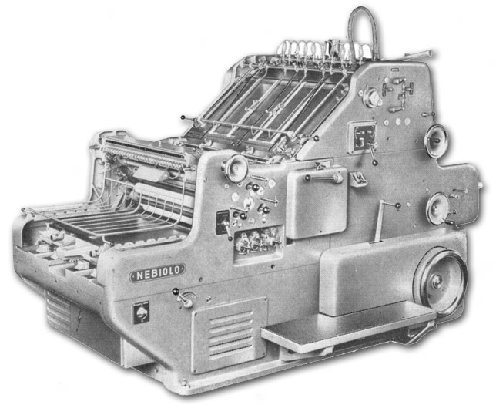|
* * * * * * * * * * * * * * * * * * * * * * * * * * * * * * * * * * * * * * * Modern era, precision-built high speed, double crown letterpress printing machine. Unlike the earlier Wharfedale type stop-cylinder format, with under the cylinder feed-board mounted paper guides and an impression cylinder which could be immobilised when the impression lever was thrown "off," the paper guides (lays) on the Nebiolo were an integral part of the cylinder/gripper mechanism and the cylinder continually rotated and required a 'throw-off' device for lifting the cylinder when impression was not required. Ample time was available for the sheet to 'settle' (ensuring accurate register) whilst the cylinder was stationary on the return stroke. Side lay was "drag" type. One 'emminent' author Sean Jennet, in "The Making of Books" (1967) states: 'jarring will occur on a stop-cylinder when the cylinder engages with the bed'. Actually, it is not a jarring action at all but a very smooth action if the press is maintained and serviced correctly. All stop-cylinder bed carriages are driven by a crank motion, that is, at the start and finish of a stroke it slows down, picking up speed till it reaches the centre and then slows down again when it gets to the other end. Therefore, as the cylinder is driven by the bed gearing, the same action applies. The same writer also says because the two-revolution cylinder does not stop, it therefore can work at a greater speed. This is nonsense of course. The above press can sit quite comfortably on maximum speed (4,000 I.P.H.) all day under favourable conditions without any ill effects whatsoever.
Picture courtesy of Arthur Johnson (Gulgong Printing Museum)
* * * * * * * * * * * * * * * * * * * * * * * * * * * * * * * * * * * * * * * * *
|
|

